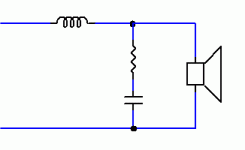Hi there everyone.
I have a basic home recording studio setup at home here with some old synths, a bunch of old microphones and a computer with a Lexicon Omega and an Mbox 2 interface.
I'm usually using a mysterious Okay-II dynamic microphone which I inherited off my brother in law, which is good as it isn't very sensitive so it picks up less background noise.
Anyway I found these old Japanese AMI Jorgen SE-25A bookshelf speakers on the side of the road. I want to use these as my monitors for my low budget studio. Obviously they won't be as good as proper monitors, but they should be better than nothing. I am thinking that as they are old, perhaps the manufactures didn't try to colour the sound too much maybe?!
I pulled the drivers out of the boxes as I was painting the front of the boxes and I noticed that whilst the tweeter has a 3.3 uf capacitor on it, there is no inductor on the woofer. I thought it might be better to have an inductor on the woofer. The woofers seem to be 5" and the tweeters seem to be 2"
The Woofers have 481121 E written on them and the tweeters have TWEETER 8Ω 0726Aa Japan 8N22D on them. I looked up on google and there was nothing came up.
Would I get a better sound for mixing with some inductors? I don't have much money to spend as I'm a stay at home father with two children, so there is not much of a budget for this.
By trial and error, I looked up on the following website and found the crossover point which seems to match the installed capacitor.
2-Way Crossover Calculator / Designer
1st Order Butterworth
5500 Hertz
8 Ohm Tweeter / 8 Ohm Woofer

Parts List
Capacitors
C1 = 3.61 uF
Inductors
L1 = 0.23 mH
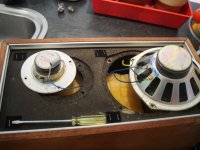
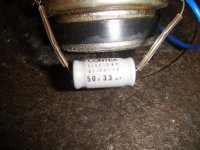
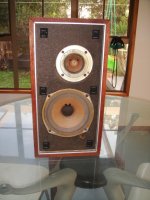
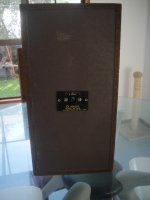
I have a basic home recording studio setup at home here with some old synths, a bunch of old microphones and a computer with a Lexicon Omega and an Mbox 2 interface.
I'm usually using a mysterious Okay-II dynamic microphone which I inherited off my brother in law, which is good as it isn't very sensitive so it picks up less background noise.
Anyway I found these old Japanese AMI Jorgen SE-25A bookshelf speakers on the side of the road. I want to use these as my monitors for my low budget studio. Obviously they won't be as good as proper monitors, but they should be better than nothing. I am thinking that as they are old, perhaps the manufactures didn't try to colour the sound too much maybe?!
I pulled the drivers out of the boxes as I was painting the front of the boxes and I noticed that whilst the tweeter has a 3.3 uf capacitor on it, there is no inductor on the woofer. I thought it might be better to have an inductor on the woofer. The woofers seem to be 5" and the tweeters seem to be 2"
The Woofers have 481121 E written on them and the tweeters have TWEETER 8Ω 0726Aa Japan 8N22D on them. I looked up on google and there was nothing came up.
Would I get a better sound for mixing with some inductors? I don't have much money to spend as I'm a stay at home father with two children, so there is not much of a budget for this.
By trial and error, I looked up on the following website and found the crossover point which seems to match the installed capacitor.
2-Way Crossover Calculator / Designer
1st Order Butterworth
5500 Hertz
8 Ohm Tweeter / 8 Ohm Woofer

Parts List
Capacitors
C1 = 3.61 uF
Inductors
L1 = 0.23 mH




Last edited:
The idea is good, woofers can be a problem up that high. It may not be this simple to do. The woofer impedance is likely to be higher than 8 ohms up top, and it will be changing with frequency. The response you want to reduce is also rising, possibly in a sharp manner.
First thoughts are that you will need to try different values of inductor, if this doesn't help then maybe a different circuit.
First thoughts are that you will need to try different values of inductor, if this doesn't help then maybe a different circuit.
So this : AMI JORGEN SE-50 | Classic Hi-Fi
Is that white cap in // with the tweeter on the pictures ?
I have had an old bookshelf with just a serie cap on the tweeter a 8" + a paper tweet (2.7 uF cap). Sounded nice.
those cabinets are made with chipboard which is good for loudspeakers as on the pictures.
Did you try t carefully re dome the tweeter with a vacum cleaner ?
Did you have not a better result by changing just the cap and the tweeters with a visaton if size is good ? (but what efficienty is the woofer ?) Soundlabs Group TW 70 - 8 Ohm
uh expensive, only 8 euros here in Europe... could find a chinese equivalent, often such tweeters can be found in the recycling wastes areas in towns.
Is that white cap in // with the tweeter on the pictures ?
I have had an old bookshelf with just a serie cap on the tweeter a 8" + a paper tweet (2.7 uF cap). Sounded nice.
those cabinets are made with chipboard which is good for loudspeakers as on the pictures.
Did you try t carefully re dome the tweeter with a vacum cleaner ?
Did you have not a better result by changing just the cap and the tweeters with a visaton if size is good ? (but what efficienty is the woofer ?) Soundlabs Group TW 70 - 8 Ohm
uh expensive, only 8 euros here in Europe... could find a chinese equivalent, often such tweeters can be found in the recycling wastes areas in towns.
Hi, I have got most of the dents out of both tweeters using just a drinking straw and my lungs. I didn't want to use the vacuum cleaner because the paper is so delicate that it would tear the paper.
It's got a 3.3 uf capacitor on the tweeter now. The tweeters are a little unusual though in that they have three terminals on them, so not exactly sure what the internal wiring is doing.
They don't sound too bad, not very exciting, which leads me to believe the frequency response is relatively flat.
I've got a TDA7297 chip amp for the amp, but it needs a bigger power supply. It's running off a 1 amp power supply only, so it distorts at higher gain.
It's got a 3.3 uf capacitor on the tweeter now. The tweeters are a little unusual though in that they have three terminals on them, so not exactly sure what the internal wiring is doing.
They don't sound too bad, not very exciting, which leads me to believe the frequency response is relatively flat.
I've got a TDA7297 chip amp for the amp, but it needs a bigger power supply. It's running off a 1 amp power supply only, so it distorts at higher gain.
Actually I noticed that my original input into the calculator was not quite right, the output gave a 3.6 uf capacitor whereas my one is a 3.3 uf.
Can I just use any inductor from an electronics shop, or does it have to be a special speaker one to not have too much resistance?
1st Order Butterworth
6000 Hertz
8 Ohm Tweeter / 8 Ohm Woofer

Parts List
Capacitors
C1 = 3.31 uF
Inductors
L1 = 0.21 mH
Can I just use any inductor from an electronics shop, or does it have to be a special speaker one to not have too much resistance?
1st Order Butterworth
6000 Hertz
8 Ohm Tweeter / 8 Ohm Woofer

Parts List
Capacitors
C1 = 3.31 uF
Inductors
L1 = 0.21 mH
If you have a DMM, disconnect the wires to the woofer and measure DCR. For a 8 ohm speaker you should get about 6 ohm.
The 8 ohm woofer impedance at the xo frequency of 6kHz would be around 16 ohm at a stab which would require an inductor around 0.42mH. You can try that and if you get a hole in the middle, then unwind half a layer and try again. Repeat if necessary and at a guess you may end up with around 0.33mH.
Use an air core inductor (for speakers) with 1mm wire. I don't know you location but you can get these at Speakerbug, Wagner, Soundlabs, Speakerbits.
An example:
Air-Core 0.42mH 18AWG
The 8 ohm woofer impedance at the xo frequency of 6kHz would be around 16 ohm at a stab which would require an inductor around 0.42mH. You can try that and if you get a hole in the middle, then unwind half a layer and try again. Repeat if necessary and at a guess you may end up with around 0.33mH.
Use an air core inductor (for speakers) with 1mm wire. I don't know you location but you can get these at Speakerbug, Wagner, Soundlabs, Speakerbits.
An example:
Air-Core 0.42mH 18AWG
Have you listened to them at all?
If so what did they sound like?
I notice that they are rated 25W max so half that for constant use but near-field that will be pretty loud as these early Japanese speakers were reasonably efficient.
First off I would pull that fibreglass out of the box [ carefully because you don't want fibres in your skin or lungs and you will want to re-use it ] and check all around the inside for glue blocks and leaks. If no leaks OK. If leaks seal the boxes all around with silicon. If glue blocks OK. If no glue blocks add them before silicon sealing. Replace the FG and add some more fine fibre polyester wadding.
Now I suggest listening to that little woofer on its own, if it has no razzle or annoying break-up at its top end I would use it as designed by the makers but if it doesn't sound smooth and even then experiment with adding a small inductor in series with the input. If you do decide to put an inductor in line then you will in my experience need to lower the point at which the tweeter is brought in, if the original capacitor was 3.3uF you may need to come down to 4.7 or 5.6uF
If so what did they sound like?
I notice that they are rated 25W max so half that for constant use but near-field that will be pretty loud as these early Japanese speakers were reasonably efficient.
First off I would pull that fibreglass out of the box [ carefully because you don't want fibres in your skin or lungs and you will want to re-use it ] and check all around the inside for glue blocks and leaks. If no leaks OK. If leaks seal the boxes all around with silicon. If glue blocks OK. If no glue blocks add them before silicon sealing. Replace the FG and add some more fine fibre polyester wadding.
Now I suggest listening to that little woofer on its own, if it has no razzle or annoying break-up at its top end I would use it as designed by the makers but if it doesn't sound smooth and even then experiment with adding a small inductor in series with the input. If you do decide to put an inductor in line then you will in my experience need to lower the point at which the tweeter is brought in, if the original capacitor was 3.3uF you may need to come down to 4.7 or 5.6uF
I've painted the boxes and removed most of the dents from the tweeters, so just need to decide if the circuitry can be improved.
I have listened to them, I just had the drivers out today and was surprised that there wasn't any inductors. I'll do those tests suggested and report back.
I'm in New Zealand, so I'm sure I can get an inductor from an electronics shop or similar. I'm wanting to not spend too much on these as they are pretty low value already.
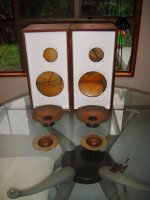
Here is the current state.
I have listened to them, I just had the drivers out today and was surprised that there wasn't any inductors. I'll do those tests suggested and report back.
I'm in New Zealand, so I'm sure I can get an inductor from an electronics shop or similar. I'm wanting to not spend too much on these as they are pretty low value already.

Here is the current state.
Don't waste money on ultra cheap capacitors tho. Are there no higher quality suppliers in NZ?
I ask as I hate paying more for postage than the items cost but caps are about $8- each and post to NZ is $19- so to buy from here [ or from the USA or the UK] might not be the cheaper option
I ask as I hate paying more for postage than the items cost but caps are about $8- each and post to NZ is $19- so to buy from here [ or from the USA or the UK] might not be the cheaper option
Does it make sense if the op wisely wants not to spend more than 20 bucks to refurbish it?
You don,t putt magnesium ferrari valves on a broken Dodge truck
The valor is the cabinet and the sound if staying cheap with thebreaked tweeter.
Why to spend on a coil if no learning project? If the woofer is gently dive and the amp les than 25 w it should be safe. And there are many speakers without low pass cause they gently dive without peaks in the upper frequency...you even do not need a precise caps, take one bipolar in a 10% precision range and you should be fine. Better you have two 6.8 uf polarized cap rated 35V? Putt two in serie with the legs in that way: + - - + and you have a non polar of 3.4 uF with just more esr and you stay in the philosophy of the project.
The idea of checking the sealing of the box is a good one.. thermal gun glue is ok for the corners and binding post and to seal the drivers on the chipboard front plate, change the wires with new one you have on hand with less oxydation. Then trust your ears by trying different stuffings with what you have from the toilett paper roll to the old pilow or the wool you saved from the neighboor sheep on the balcony (NZL without a sheep joke...can't resist, sorry). Involve the family kids as a green and learning project...cool and story to tell...
Ah and why not a high pass on the woofer and give it a cool 30 to 50 hz first order high pass to protect it and play...zero bucks, just look at what you have on your work shop.
You guys forgott what simplicity is and where you come from . I like the down the road story and the philosophy of the project. As say Shane an australian mate, just putt a radio on a cabin boat or a kitchen when washing the plates = happyness.
You don,t putt magnesium ferrari valves on a broken Dodge truck
The valor is the cabinet and the sound if staying cheap with thebreaked tweeter.
Why to spend on a coil if no learning project? If the woofer is gently dive and the amp les than 25 w it should be safe. And there are many speakers without low pass cause they gently dive without peaks in the upper frequency...you even do not need a precise caps, take one bipolar in a 10% precision range and you should be fine. Better you have two 6.8 uf polarized cap rated 35V? Putt two in serie with the legs in that way: + - - + and you have a non polar of 3.4 uF with just more esr and you stay in the philosophy of the project.
The idea of checking the sealing of the box is a good one.. thermal gun glue is ok for the corners and binding post and to seal the drivers on the chipboard front plate, change the wires with new one you have on hand with less oxydation. Then trust your ears by trying different stuffings with what you have from the toilett paper roll to the old pilow or the wool you saved from the neighboor sheep on the balcony (NZL without a sheep joke...can't resist, sorry). Involve the family kids as a green and learning project...cool and story to tell...
Ah and why not a high pass on the woofer and give it a cool 30 to 50 hz first order high pass to protect it and play...zero bucks, just look at what you have on your work shop.
You guys forgott what simplicity is and where you come from . I like the down the road story and the philosophy of the project. As say Shane an australian mate, just putt a radio on a cabin boat or a kitchen when washing the plates = happyness.
I've painted the boxes and removed most of the dents from the tweeters, so just need to decide if the circuitry can be improved.
I have listened to them, I just had the drivers out today and was surprised that there wasn't any inductors. I'll do those tests suggested and report back.
I'm in New Zealand, so I'm sure I can get an inductor from an electronics shop or similar. I'm wanting to not spend too much on these as they are pretty low value already.
View attachment 840499
Here is the current state.
I think you better stay off an inductor as this will only create phase problems. The small values you mention above will not affect the freq-curve much anyway. Just get a better polyprop speaker-capacitor with the same value as the original from an electronics shop and leave it as that.
The wood-boxes are nice and when you can afford it, you can buy new drivers/filters and reuse that old box.
That the middle way...+1..
Raw blitz add-wize for the lucky pet.
If you have old copper coil, ask fellow AllenB the number of turns for the needed coil value 🙂.
...my two daughters are on the habit to say rabbitz...
Raw blitz add-wize for the lucky pet.
If you have old copper coil, ask fellow AllenB the number of turns for the needed coil value 🙂.
...my two daughters are on the habit to say rabbitz...
Thanks for the hints. Doing a little bit of reading on the forum and elsewhere it seems that it should be pretty straightforward to wind my own inductors. I should be able to scavenge some wire from some old transformers or motors.
Any idea on the minimum thickness wire I should use?
If i can wind my own inductors, it would cut down on the cost which would be ideal.
Any idea on the minimum thickness wire I should use?
If i can wind my own inductors, it would cut down on the cost which would be ideal.
A diy coil can range from #24 to #18 AWG. The greater the inductance required, the thicker the wire you should use in order to cut down DC resistance. For example, for 0.25mH use #24, for 2.5mH use #18.Any idea on the minimum thickness wire I should use?
P.S. I'm with diyiggy. Let that mid/woofer run free. No inductor and a 3.3uF polypropylene capacitor on the tweeter. Splash that sound around! 🙂
I found some capacitors at a local store:
CF3.3F - 3.3UF 100V P.FILM 22M5 10%
NZ$5.22
Metalised Polyester Capacitors - South Island Component Centre 2006 Ltd.
However it is a pretty big investment as I'd have to buy two, would they make a big difference?
I have looked at a couple of circuit boards which I have lying around to see if there are any I can scavenge, but they all are much smaller value, in the yellow box type of capacitor. I'll have to look at some other scrap boards to see if there is anything.
Cheers,
Sam
CF3.3F - 3.3UF 100V P.FILM 22M5 10%
NZ$5.22
Metalised Polyester Capacitors - South Island Component Centre 2006 Ltd.
However it is a pretty big investment as I'd have to buy two, would they make a big difference?
I have looked at a couple of circuit boards which I have lying around to see if there are any I can scavenge, but they all are much smaller value, in the yellow box type of capacitor. I'll have to look at some other scrap boards to see if there is anything.
Cheers,
Sam
Nah. And I will paraphrase my guru here when it comes about filters (AllenB) : bipolar lytics are just fine and do the job with speakers filters. A film cap has zero interest in your project but the precision of the capacitance value... which you really don't mind here, Film caps are just a plus for expensive filter and you are in the dimunishing return...
Though not sure speakers bipolar lytics cost less though than polyester caps you linked and where you live!
So two way, you find 4 x 6.8 uF /50V like the green Nichicon Muse or Elna Silmic II to make bipolars like I explain, hopping it will cost you not more than 5 bucks at the local shop... but dunno about choice about audio caps in mortar local shop. Or better if yu have 4 from your work shop or an old device... free and it should not arm as the tweeters had center dome hard return to life.
The caps the shop want to sell are Polyester, it's ok and stand between lytics and polypropylene which are not costing much but audio branded caps.
Think money best spent in new tweeters as the Visaton but it's another project. And Indeed parts seems to be costy where you live...
Though not sure speakers bipolar lytics cost less though than polyester caps you linked and where you live!
So two way, you find 4 x 6.8 uF /50V like the green Nichicon Muse or Elna Silmic II to make bipolars like I explain, hopping it will cost you not more than 5 bucks at the local shop... but dunno about choice about audio caps in mortar local shop. Or better if yu have 4 from your work shop or an old device... free and it should not arm as the tweeters had center dome hard return to life.
The caps the shop want to sell are Polyester, it's ok and stand between lytics and polypropylene which are not costing much but audio branded caps.
Think money best spent in new tweeters as the Visaton but it's another project. And Indeed parts seems to be costy where you live...
Last edited:
Hey Tyger most people here would consider a $5- capacitor cheap.
I don't personally subscribe to the idea that a $300- capacitor sounds a hundred times better than a $3- capacitor but I can hear the difference between a cheap one and a middle of the range unit. diyiggy the OP lives in New Zealand and everything there is ten times USA prices, except sheep, sheep are cheap [ obligatory NZ sheep crack]
Do not use the Jaycar
3.3uF 100V Electrolytic Crossover Capacitor | Jaycar Electronics New Zealand
OR these
1.5uF 250V Metallised Polypropylene Crossover Capacitor | Jaycar Electronics New Zealand
The green ones will work in subwoofers but higher than that they sound awful and I do not have golden or even silver ears. The yellow ones are absolute crap for music
Let me look in my junk drawer I might be able to spot some S/H ones to send you.
I don't personally subscribe to the idea that a $300- capacitor sounds a hundred times better than a $3- capacitor but I can hear the difference between a cheap one and a middle of the range unit. diyiggy the OP lives in New Zealand and everything there is ten times USA prices, except sheep, sheep are cheap [ obligatory NZ sheep crack]
Do not use the Jaycar
3.3uF 100V Electrolytic Crossover Capacitor | Jaycar Electronics New Zealand
OR these
1.5uF 250V Metallised Polypropylene Crossover Capacitor | Jaycar Electronics New Zealand
The green ones will work in subwoofers but higher than that they sound awful and I do not have golden or even silver ears. The yellow ones are absolute crap for music
Let me look in my junk drawer I might be able to spot some S/H ones to send you.
- Home
- Loudspeakers
- Multi-Way
- Beginner -using old bookshelf speakers as budget studio monitors, crossover advice
